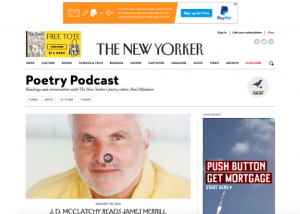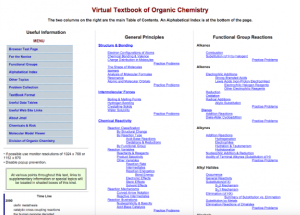General Interest
Back to Top
|
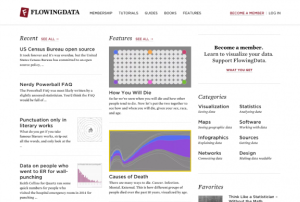 |
|
FlowingData
|
Science |
|
For readers who love data - and the visual representation of data - this site from statistician Nathan Yau will provide hours of brainy entertainment. Readers may like to scout the site by Categories, such as Visualization (Seeing data), Statistics (Analyzing data), and Maps (Seeing geographic data), among others. They may also explore Recent data representations, which, at the time of this writing, included a lottery simulator, an analysis of the character appearances in the classic romantic comedy Love Actually, and a visual representation of all 1,942 currently known exoplanets. There are also excellent Tutorials, such as How to Make an Interactive Bar Chart with a Slider; however, these require a monthly membership with FlowingData, for a $5 per month fee. [CNH] |
|





|
|
 |
|
ArtsJournalBlog: CultureGrrl
|
Arts |
|
Lee Rosenbaum has written for The Wall Street Journal, The New York Times, and a number of major art magazines. In addition, her blog, CultureGrrl, won a "best blog" award way back in 2009 and has been a major voice in the art world ever since. Here readers will find more-or-less weekly posts on museum exhibits, art auctions, and nights at the opera, as well as learned reviews of art, both contemporary and classic. Recent posts have included a review of the Metropolitan Museum's Ancient Egypt show (with video), an overview of the Association of Art Museum Directors' (AAMD) bid to save ancient art works from ISIS, and a recent "Shakeup at the National Academy," in which director Carmine Branagan left the organization under undisclosed circumstances. Readers may also enjoy the My Work Elsewhere section, where they can link to Rosenbaum's op-eds, reviews, and articles in major newspapers, and, perhaps especially, her educational appearances on public radio (one warning: some of the older links are broken). [CNH] |
|





|
|
 |
|
UCSB Cylinder Audio Archive
|
Arts |
|
Cylinder recordings, which predated vinyl records, were the first commercially produced sound recordings of the late nineteenth and early twentieth centuries. On this site, hosted by the University of California, Santa Barbara (UCSB) Cylinder Audio Archive, readers will find more than 10,000 cylinder recordings that cover the gamut, from popular songs to vaudeville acts to opera, and more. To scout the site, readers may like to select Discover, which navigates to a Browse Collection page where readers will find the entire collection divided up by Genre (Band Music, Cakewalks, Carols, Fiddle Tunes, etc.), Instruments (Accordion, Bagpipes, Banjo, etc.), Topical Subject (Baseball, Disasters, Prohibition, etc.), and Ethnic and Foreign Cylinders (Argentine, Austrian, Balkan, etc.). Readers may also use the excellent search function to locate a specific cylinder by keyword, author, title, subject, year, or UCSB call number. Indeed, the UCSB Cylinder Audio Archive is a well-organized and wonderful peek into America's musical and cultural past. [CNH] |
|





|
|
 |
|
Expert Enough: The Lost Art of Becoming Good at Things
|
Philosophy |
|
Expert Enough, a blog by Corbett Barr and Caleb Wojick, two young entrepreneurial polymaths, begins with a simple premise: "We are all capable of so much more than we think." From there, Barr and Wojick posit that one doesn't need to be the world's greatest expert in anything, just "expert enough" to accomplish prescribed goals, and that it actually takes "surprisingly little effort in most fields" to gain that expertise. After skimming the homepage, which lays out the Expert Enough philosophy, readers may like to dive in to the site's most popular articles, which include such missives as "The Lost Art of Becoming Good at Things," "Deliberate Practice: What It Is and Why You Need It," and "The Expert Enough Manifesto." From there, explore the full archives to find recent posts such as "Become an Expert DJ in Two Months" and "10 Steps to Create a Standing Ovation Worthy TED Talk," as well as a Most Used Categories section and archives organized by year and month. While it seems that the Expert Enough blog is currently on hiatus, there are plenty of interesting ideas here for readers that would like to learn new subjects. [CNH] |
|





|
|
 |
|
Telecom, Internet, & Information Policy
|
Social studies |
|
For readers who would like to peruse a well-argued libertarian perspective on tech issues, the Cato Institute's Telecom, Internet, and Information Policy section is a learned place to start. Here readers will find commentary on such topics as Free Speech and Technology, Intellectual Property, Internet Governance and Regulation, Privacy Issues, and Telecom Regulation. Recent articles have tackled the issue of whether or not police officers should be mandated to wear body cameras, a call to streamline the financial regulatory system to allow for greater innovation and efficiency, and a denouncement of current problems at the NSA. In addition, the Multimedia section includes scores of interviews and discussions that showcase the views of CATO scholars as they take on other commentators and advance their ideas on major news programs. [CNH] |
|





|
|
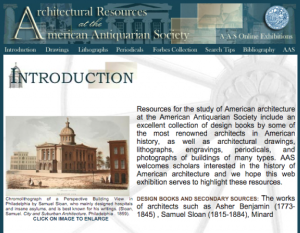 |
|
Architectural Resources at the American Antiquarian Society
|
Arts |
|
This online collection from the American Antiquarian Society boasts design books from some of America's most renowned early architects, as well as a wide array of architectural drawings, lithographs, engravings, periodicals, and photographs of classic American buildings, such as the home of Louisa Mary Alcott. Here readers will find the works of Asher Benjamin, whose late eighteenth- and early nineteenth-century architectural vision shaped American cityscapes through the Civil War era. Readers will also find much to admire in the featured design books of Samuel Sloan, Minard Lafever, and Charles Bulfinch, all of whom influenced the development of American architecture. After reading the informative Introduction, the various categories of Drawings, Lithographs, and Periodicals provide a glimpse into the burgeoning architectural trends of early America. For readers who would like to browse the collection more thoroughly, the Search Tips tab provides helpful advice for how to make the most out of the American Antiquarian Society's holdings. [CNH] |
|





|
|
 |
|
NPR: Music Reviews
|
Arts |
|
What is perhaps most striking about National Public Radio's Music Reviews is the sheer range of what is reviewed. The excellent writing, however, always demands mention, as Will Hermes, Oliver Wang, and others delve into the wonders of folk albums, pop anthems, jazz compilations, movie soundtracks, and more. Recent articles have explored the best albums of 2015 ("From Hip-Hop To Country," by Ken Tucker), reviewed ZZ Top front man Billy Gibbon's first solo album, and extolled the "big blocky chords and loud piano sounds" of jazz pianist Matthew Shipp's "Conduct of Jazz." There are also links to Fresh Air episodes that concern music and musicians, and the All Songs 24/7 Music Channel, where readers can listen to a continuous stream of songs that have played on NPR's All Things Considered. [CNH] |
|





|
|
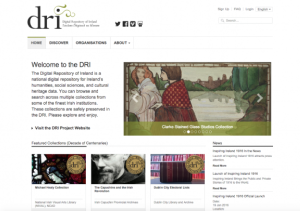 |
|
Digital Repository of Ireland
|
Social studies |
|
The Digital Repository of Ireland (DRI) skillfully works to preserve and share the data, objects, and narratives that contextualize Ireland's rich cultural heritage. Providing access to over 2,200 historical and contemporary items physically housed in collections across the country, the portal acts as a central hub, offering interactive multimedia tools and digital resources to archivists, researchers, educators, historians, and the interested public. Readers can find out more about the contributing institutions under Organisations, or browse/search the repository through the Discover section. Perhaps best of all, readers may opt to Visit the DRI Project Website to explore a sampling of current projects and online exhibits. For instance, just this January the DRI launched Inspiring Ireland 1916, a two-part project with an award-winning website that presents objects from Ireland's National Cultural Institutions alongside publicly collected memorabilia to commemorate the 1916 Easter Rising. [CBD] |
|





|
|

